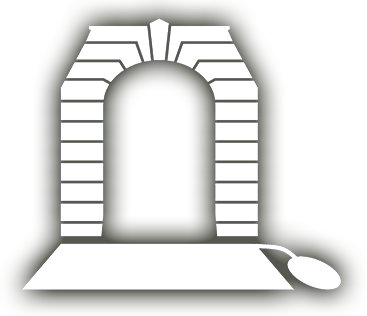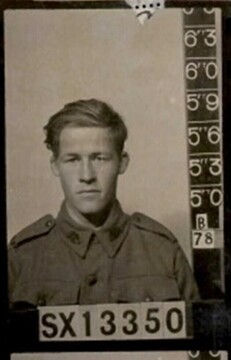ST CLAIR, Douglas Charles
| Service Number: | SX13350 |
|---|---|
| Enlisted: | 23 June 1941, Adelaide, SA |
| Last Rank: | Private |
| Last Unit: | 2nd/48th Infantry Battalion |
| Born: | Renmark, South Australia, 29 May 1921 |
| Home Town: | Renmark, Renmark Paringa, South Australia |
| Schooling: | Not yet discovered |
| Occupation: | Labourer |
| Died: | 26 January 1977, aged 55 years, cause of death not yet discovered, place of death not yet discovered |
| Cemetery: |
Centennial Park Cemetery, South Australia General Section F Path 11 Plot 411. |
| Memorials: |
World War 2 Service
| 23 Jun 1941: | Involvement Private, SX13350 | |
|---|---|---|
| 23 Jun 1941: | Enlisted Adelaide, SA | |
| 23 Jun 1941: | Enlisted Australian Military Forces (WW2) , Private, SX13350, 2nd/48th Infantry Battalion | |
| 7 Mar 1946: | Discharged | |
| 7 Mar 1946: | Discharged Australian Military Forces (WW2) , Private, SX13350, 2nd/48th Infantry Battalion |
A Challenging Life.
Douglas, one of ten children, was born in the Riverland town of Renmark, on the 29th May, 1921 to Charles (Charlie) and Lucy Evelyn St Clair. His father was a professional fisherman on the Murray, often absent for long periods when he would camp on the river banks. His knowledge of the river was gleaned over decades, monitoring the quality and variety of species and the health of the River itself.
Douglas was eight when his 39-year-old mother, who had been ill for some time, died in the Renmark Hospital, just two weeks after delivering her latest child on the 8th January ’30. His Glasgow-born father, Charlie died in November that year in the same Hospital
Aged 20, Doug, a labourer enlisted on the 22nd June ‘41 claiming that he neither knew if his father was living and if so, his address. He initially nominated William Flavel Green as there was no guardian. This later changed and he nominated his sister Mrs C.M. Wilde from Saddleworth (in July ’43)
Doug was allocated the number SX13350 and placed in the 2/48th Battalion Reinforcements. He arrived in the Middle East on the 20th October, immediately undertaking intensive training. His leadership skills resulted in him being targeted for Officers’ School in January the following year.
Back home, in January’42, 19-year-old Lawrence Charles St Clair, a non-swimmer, drowned in Ral Ral Creek, having dived in to bathe. He had just signed up to serve the Army. He had been living in a tent with two of his brothers, Bill and Norman alongside his aunt Alice and uncle Charles Wilson’s home, having his meals with the Wilson family. His cousin Daisy, a competent swimmer, had already been in for a swim, but had warned Lawrence of the depth of the water, but he ignored her. Seeing him in trouble, Daisy attempted a rescue but was put in danger herself so swam to shore seeking help, although none of the brothers or her parents could swim.
Tragedy again struck at the end of that year in December. Douglas’ 17-year-old younger brother, Norman John drowned at Lock 8 in the early hours. He also was not a strong swimmer despite being employed as a deck hand on the steamer, S.S. Renmark, as was his brother Bill. The boat had passed through the lock, but Norman was swept off the deck by a towline attached to a barge and fell Into the River, between the two barges. Despite a young man diving into the water, Norman did not surface. Days later his body was recovered when workmen were replacing boards in the lock.
In the Middle East,in July, Douglas presented with a gunshot wound to his right foot. This was during the frenetic time that his battalion was heavily involved in the advance to capture Tel el Eisa station with the 2/48th repelling numerous counter attacks. The 2/48th Battalion suffered 215 casualties between the 7th July and 23rd October. Of that number, 64 men were killed and six, died of their wounds. 125 other men were wounded but survived. A fellow young soldier, 22-year-old Ray Bloffwitch SX7866 of D Company was in the thick of the fighting which he described as;
“The noise was terrific: German machine guns were spreading the fire right across our front. The continuous call for stretcher bearers told of our casualties.”
With that background, Douglas’ action was understandable. However, a Court of Inquiry was held, determining that the wound was self-inflicted. Once it was healed, Douglas returned to his 2/48th Battalion in October ’42.
Back home, The August issue of the Chronicle published a list of those killed or wounded in that action in action in August ’42. From Doug’s battalion, they included SX1312 Pte. Reginald W. C. Brown Whyalla. SX12765. Pte. Charles A. Corfield Clare. SX7166 Pte. Arthur R. Davis Rosewater SX13018 Pte. Colin J. Hanley Port Augusta. SX8236 Pte. Gerald J. Hayes. Wirrabara SX6297 Pte. Donald S. Ridley Loxton SX11052. Pte. Walter M. Shane. 2/48th Spalding and SX8315 Pte. Robert O. Sunman. Port Augusta. Died Of Wounds SX8087 Cpl. Francis W. Fletcher, Aldgate SX8454 Cpl. Arthur A. Harding. Peterborough. Wounded In Action SX10613 Pte. Percy H. Evans,. Stirling East. SX8178 Pte. William E. G. Snider. Peterborough. SX6639 Pte. Gilbert M. Speck. Croydon. Accidentally Wounded SX13350 Pte. Douglas C St. Clair. Seaton Park. Believed Prisoner Of War SX13037 Pte. Melvin R Maynard. Clare. (Aged 17 he enlisted as Melvin Reginald, an assumed name, but was Allen Sydney Maynard.)
However, the effects of the intense war conditions contributed to Douglas going absent without leave and receiving a fine.
The much-anticipated return of the 2/48th Battalion to Australia finally occurred at the commencement of February ’43, with Doug sailing home via Melbourne.
Following leave, he headed to Queensland, undertaking training in preparation for facing the heat and humidity of combat in New Guinea. He arrived in Milne Bay early in August ’43. As did so many, Doug contracted an extremely high fever, Pyrexia of Unknown Origin and malaria, the latter which continued to erupt despite a return to Australia in March ’44. He was reported as ‘recovered from serious illness’ in April that year.
A further day of AWL again resulted in a fine but in April ’45 Douglas returned to service for the closing phase of the war, arriving in Morotai and thence to Tarakan. He was finally to return to South Australia for discharge on the 7th March ‘46
Following his discharge, a photo was published in the Mail in June ‘47, announcing Douglas’ engagement to Daphne Whetstone, of Hyde Park.
Aged 56, Douglas died on the 26th January ’77 and now rests in the Centennial Park Cemetery General Section F Path 11 Plot 411.
Researched and written by Kaye Lee, daughter of Bryan Holmes SX8133, 2/48th Battalion.
Submitted 25 September 2025 by Kaye Lee










